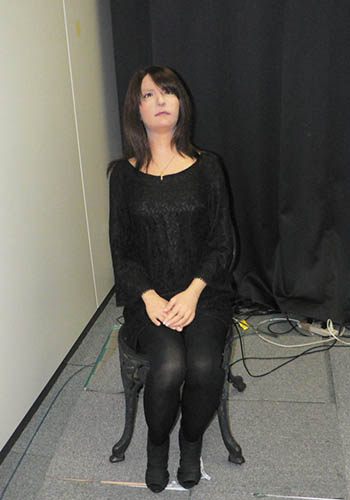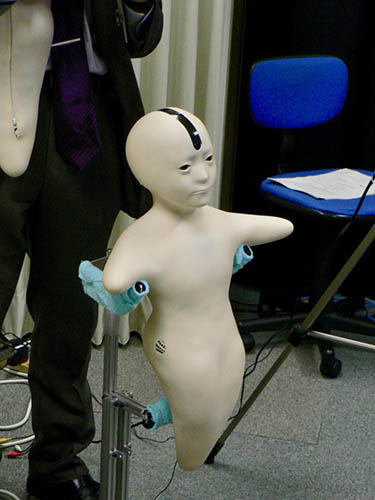In their thoughtful provocation, Jon Bialecki and Ian Lowrie focus our attention on anthropos, and suggest that in transhumanists, anthropologists might find kindred spirits. Though our approaches and traditions may differ, we share “the same conceptual terrain.” Concerned as we all are about shifts in our ways of living and being in a “rapidly accelerating technological contemporary,” transhumanists and anthropologists may indeed have much to learn from each other about future forms of anthropos. But implied in their discussion is a convergence between “anthropos” and “human.” What is at stake in making this equation? Transhumanists and anthropologists alike are tuned into the future of the human, but we should also remember that futures are never very evenly distributed.
My work has focused on figuring out the contours of a similar problem space. My main ethnographic study was on a network of researchers in Japan who make what they call ningen-chūshin gijutsu (人間中心技術), roughly “human-centered technology.” These take the forms of humanoid and non-humanoid robots, and various types of wearable technologies. Much of what they develop are interface technologies that operate on a variety of senses: vision, hearing, and touch, but also balance and proprioception. These researchers want to use such interfaces to make humans faster, more efficient, or more comfortable, or link them to machines to off-load repetitive tasks to free up a human for more demanding or interesting things.
With a broad aim of enhancing human capabilities at work and at home, these researchers check off many of the boxes needed to classify them as “transhumanist.” They even share some cultural touchstones. I learned at my first North American transhumanist conference back in 2010 that more than a few transhumanists are fond of the Japanese animé Ghost in the Shell. One former director of a transhumanist group, Humanity+, called it “the most fully realized earth-based Transhumanist vision.” For some of my Japanese interlocutors, the Ghost in the Shell comic book was required reading when they joined the lab, because it was in the judgement of that lab’s leaders a good approximation of the world they were trying to create. Nevertheless, “transhumanist” was not a label that they applied to themselves, and I was never comfortable calling them transhumanists. It took me some time to realize that my difficulty had to do with the “human” part.
The translation of “human” into “ningen” (人間) is a useful but rough one, and it is simply one among a list of other candidate translations in Japanese. “Anthropology” is in Japanese Jinrui-gaku (人類学), although jinrui (人類) works as “humankind” or “humanity” as well. Hito (ひと) is a good everyday translation, although the connotations of hito vary depending on whether it is rendered in kanji, hiragana, or katakana script (人、ひと、ヒト). In katakana, hito appears technical and objective, more like Homo sapiens than “human.” There is also the phonetic transcription of human as hyūman (ヒューマン), which appears more comfortable in corporate names and slogans, or pop song titles than it does in everyday speech. When the “human” arrived in Japan, it called at more than one home.[1]

The Geminoid F | Photo by author
Even more than ningen-chūshin gijutsu, my interlocutors would refer to their technologies as hitorashī or ningenrashī (人らしい、人間らしい), “human-like.” A humanoid robot like the Geminoid-F was ningenrashī because it looked like a person, all the way down to the texture of her silicone skin. But other devices that looked nothing like a human were also ningenrashī: a set of LCD display goggles, or a pair of joysticks on a table, for instance. They were ningenrashī not because they looked human, but because they felt human.
In ordinary use, hitorashī and ningenrashī imply a kind of propriety or ethical normativity—to live in a salutary way is to be hitorashī, for instance. Thus, the use of hitorashī to talk about machines does not necessarily mean that they look human, but that they act like a human. Of course in English, “human” has similar physical and ethical connotations: to call someone “inhuman” is more of a moral judgement than a biological one. But to my interlocutors, it seemed that to act like a hito required a more fundamental awareness. It included not just the norms of social propriety, but also the most basic act of selecting what sensory modality to communicate with, be it sound, touch, or something else. Hence their interest in interfaces that worked across many senses. Thus, the Geminoid-F is not hitorashī because it has the physical appearance of a human being, but because in its construction, it is designed to interface with people through the senses that they ordinarily expect people to use in specific situations.
This is not a material or biological determinism. For an ordinary person to be hitorashii is an achievement, one that can be pursued both through moral education as well as physical training. (This is related to the reason that among superheroes, Superman only needs to change his costume, while a Super Saiyan has to train to change his or her body. They only change clothes when they come under a new master.) For a machine, this opens up additional ways of being hito beyond “human.” Even if a machine looks non-human and has no sophisticated programming, it can be hitorashī provided it is placed in situations where other people would have only modest expectations of it. The bar for being a hito is different for a robot sitting beside you in a cafe, and a robot waiting in line behind you.

The “Telenoid,” a later hitorashī robot | Photo by author
From this perspective, transhumanism, if human is directly replaced with hito, becomes problematic because it implies leaving behind one’s basic ethical responsibilities. The common transhumanist mantra of becoming “better than well,” cannot but also sound to hito like, “better than the rest of you.” If there is a corresponding mantra for hitorashī technologies, it is perhaps to “live better with others.” (Of course, “others” here does not mean “everyone.”)
If we want to maintain anthropos as a capacious category, as a dialogue that you don’t have to know the language to join, then I think it’s imperative to keep our ears open to the challenges that any such dialogue holds. Rough translations go a long way, but the differences that become legible across translation go further still. For some, perhaps a large portion of us, anthropos=human, and this can be the beginning of a productive discussion. But, anthropos is also hito, even if hito does not quite equal human. The divergence between them is also a part of our historical moment, and it is something that can make new and interesting problems in our shared problem space.
References
Chakrabarty, Dipesh. Provincializing Europe: Postcolonial Thought and Historical Difference. Princeton and Oxford: Princeton University Press, 2000.
Sakai, Naoki. Translation and Subjectivity: On “Japan” and Cultural Nationalism. Minneapolis: University of Minnesota Press, 1997.
Satsuka, Shiho. Nature in Translation: Freedom, Subjectivity, Japanese Tourism Encounters in Canada. Durham and London: Duke University Press, 2015.
Viveiros de Castros, Eduardo. “Cosmological Perspectivism in Amazonia and Elsewhere.” In Hau: Masterclass Series 1. Hau: Masterclass Series 1. Manchester: HAU Network of Ethnographic Theory, 2012.
Grant Jun Otsuki is an assistant professor in the Faculty of Humanities and Social Sciences at the University of Tsukuba, Japan.
[1] For more on translation, specifically between Japanese and Western languages, see Sakai (1997) and Satsuka (2015). In addition, Chakrabarty (2000) and Viveiros de Castro (2012) discuss the translation of “human.”
